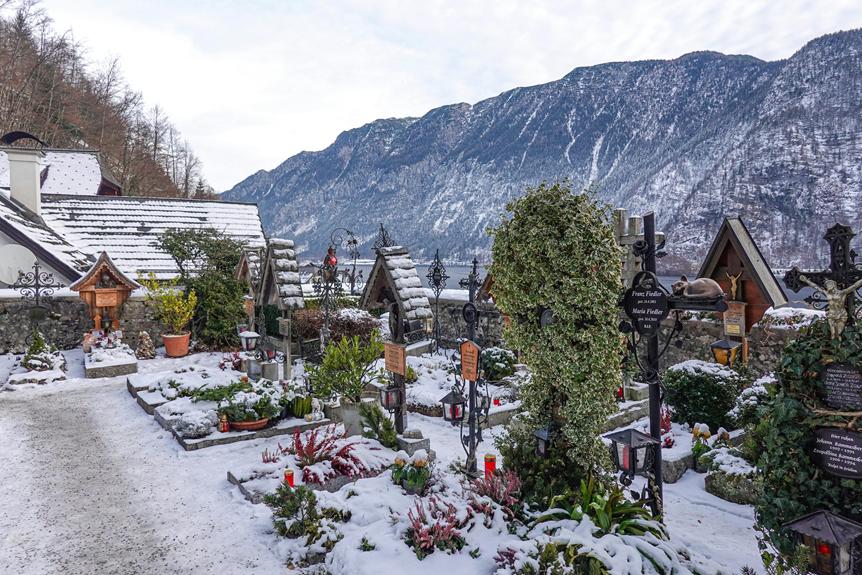As I watched the delicate petals of my prized orchid wilt under the frost's icy grip, I realized the fragility of plants in winter. Ensuring their survival demands foresight and care.
But fear not, for in this guide, I will unravel the secrets to fortifying your plants against the cold's harsh embrace. Join me as we uncover the essential strategies and tips to shield your green companions from the winter chill and witness them thrive even in the bleakest of seasons.
Plant Cold Tolerance Assessment
When evaluating plant cold tolerance, I prioritize researching each plant's ability to withstand low temperatures before winter arrives. Understanding which plants can thrive in colder conditions helps me plan effectively for the upcoming season.
By knowing the cold hardiness of each plant, I can prioritize them based on their ability to survive in the changing weather. Considering forecasted temperatures and the duration of cold spells further aids in decision-making.
Utilizing tools such as the PictureThis app for plant identification enhances my ability to assess their cold tolerance accurately. This proactive approach ensures that I can take the necessary steps to protect vulnerable plants and help them survive the winter months successfully.
Indoor Plant Protection Tips
To safeguard indoor plants during cold weather, consider relocating them to a garage, basement, or attic for protection. Moving them indoors can shield them from harsh winter conditions. Ensure the new location provides adequate light and air circulation.
Be mindful of the temperature in these spaces, as extreme cold can still harm the plants. Check for drafts and cold spots and adjust accordingly. Keep a close eye on the moisture levels in the soil, as indoor environments can be drier.
Consider using a humidifier or pebble trays to increase humidity. Regularly inspect the plants for any signs of stress or pests. With proper care and attention, your indoor plants can thrive through the winter months.
Mulching and Covering Techniques
Mulching and covering play key roles in protecting plants during cold weather. Proper techniques can help shield plants from freezing temperatures and harsh winter conditions.
- Mulch insulates plants against temperature drops
- Wet soil retains more heat than dry soil
- Use breathable fabric or landscape fabric to cover plants
- Ensure blankets reach the ground and use garden stakes to secure covers
Utilizing Ambient Heat Sources
Utilizing ambient heat sources is essential for safeguarding plants during cold weather spells. When temperatures drop, wrapping incandescent Christmas lights around plants can provide much-needed warmth. I recommend using old-school C9 bulbs for additional heat, ensuring not to overload electrical circuits.
Introducing heat sources under covers can offer added protection, but remember that LEDs don't generate heat. Placing these heat sources strategically can make a significant difference in protecting your plants from frost damage. By utilizing ambient heat sources effectively, you can create a warmer microclimate that helps your plants survive the winter chill.
This proactive approach can mean the difference between thriving plants come spring or struggling to recover from the cold.
Post-Freeze Plant Care
After ensuring the ambient heat sources are properly utilized, the focus shifts to post-freeze plant care and recovery.
- Assess Damage: Check for signs of frost damage on leaves and stems.
- Monitor Moisture Levels: Ensure soil is neither too dry nor waterlogged.
- Avoid Immediate Pruning: Wait to prune until the extent of damage is clear.
- Provide Gentle Care: Offer extra protection and care to aid in plant recovery.
Winter Plant Survival Strategies
To ensure the survival of your plants during winter, consider implementing a variety of protective measures and strategies. Some effective winter plant survival strategies include insulating plants with mulch and coverings, providing ambient heat sources, and protecting plants indoors. Here's a breakdown of these strategies in a simple table:
| Winter Plant Survival Strategies | Description |
|---|---|
| Insulating with Mulch | Add pine straw or mulch to trap air around plants for insulation against temperature drops. Wet soil retains more heat than dry soil. |
| Providing Ambient Heat | Wrap incandescent Christmas lights around plants or use old-school C9 bulbs for additional heat. Avoid overloading electrical circuits and introduce heat sources under covers for added warmth. |
| Protecting Indoors | Transport small-to-medium pots indoors, relocate plants to a garage or attic, and protect potted plants from wind. |
Preventing Frost Damage
When preparing for winter plant survival, it's essential to focus on preventing frost damage by implementing protective measures such as insulating plants, providing heat sources, and ensuring indoor protection.
- Cover delicate plants with frost cloth or blankets
- Use hot caps or cloches for individual plants
- Water plants thoroughly before a freeze to prevent dehydration
- Place potted plants close to the warmth of a building
Taking these precautions can significantly reduce the risk of frost damage to your plants. By being proactive and attentive to the needs of your garden during the colder months, you can help ensure that your plants stay healthy and vibrant even in the face of frosty conditions.
Emergency Winter Plant Care
During extreme winter conditions, immediate action is crucial to safeguard vulnerable plants and ensure their survival. Here are some emergency winter plant care tips to help protect your beloved greens:
| Emergency Winter Plant Care Tips | ||
|---|---|---|
| Tip 1: Assess plant damage quickly | Tip 2: Provide shelter from harsh winds | Tip 3: Remove snow buildup to prevent breakage |
| Tip 4: Water plants adequately but avoid overwatering | Tip 5: Prune damaged branches carefully |





